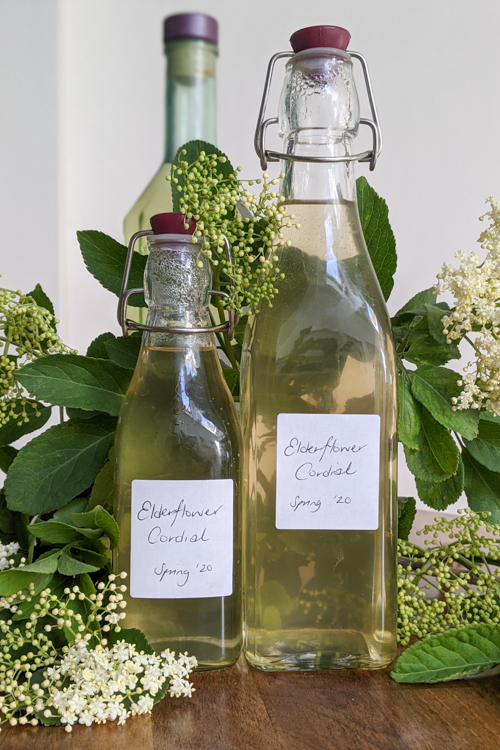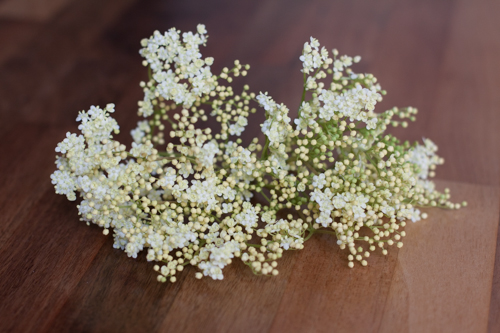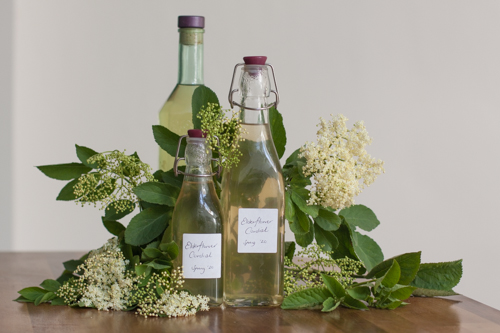Recipes for lockdown: Elderflower cordial
 Monday, May 18, 2020 at 8:55PM
Monday, May 18, 2020 at 8:55PM 
My first attempt at making elderflower cordial a few year’s ago didn’t go very well. I followed the key piece of advice I had been given, namely, to pick the flowers right at the beginning of the season just as they start opening. I was on the lookout every time I walked or ran along the Parkland Walk in Finsbury Park and, as soon as the little white flowers started blossoming, I started foraging.
I also took care to inspect the flower heads for insects and discarded any that looked like they might have a little colony. I then poured boiling water over them and leftover night to infuse. The next day I strained, added sugar and lemon juice and simmered to dissolve the sugar. The result was… sugar syrup. Not a hint of elderflower. I ended up using it as a sweetener for cocktails and thought no more about it until last year…
The M&2V, my mum and I were walking in Kingswood in early spring when I saw that the elderflower was just coming out again and pointed it out to the others. They both started laughing.
What is so funny?
That’s not elderflower, it’s cow parsley.
Oh.
Cow parsley cordial. I still haven’t managed to live that down. The M&2V brings it up any opportunity he gets, which is quite often, as it is peak season for cow parsley at the moment and we are cycling everyday.
It is also just coming into elderflower season - I can say that with confidence now, as the M&2V showed me the real thing last spring and, more importantly, the cordial I made yesterday actually tastes like elderflower.
This is a great thing to make in lockdown, as you can pick elderflower for free from hedgerows and trees on your daily outing and it also provides a novel way to jazz up your G&T, which you'll be grateful for if you've been drinking them like they are going out of fashion, as I have been.
It is the perfect time to pick them right now, because there are still plenty of tiny buds that are just starting to open. These are said to have the most flavour... and I can confirm now that this is true.

Makes approx 1.75L.
Ingredients
Approx 30 elderflower heads
Zest & juice of 3 unwaxed lemons
2L water
900g sugar
1.5 tsp citric acid (if you plan to store it for longer than a few weeks)
Method
Check the elderflower heads carefully and either discard any with insects or remove the insects if you can. Put the elderflower heads in a bowl with the lemon zest.
Bring the water to the boil in a large saucepan. When it comes to the boil, remove from the heat and put the elderflower and lemon zest in the boiling water. Make sure all the elderflower and lemon zest is under water – use a wooden spoon to push it down if not. Cover and leave to infuse overnight.
Sterilise the glass bottles you intend to store the cordial in with boiling water.
Add the juice of the 3 lemons to the saucepan. Strain the liquid through a sieve into a large bowl to remove the large plant material. Then strain again trhough a piece of muslin into a large saucepan (if using the same saucepan, wash it first to remove any fine plant matter). If you don’t have muslin, a cotton teatowel will do the job.
Add the sugar and citric acid, if using, and gently heat over a medium heat to dissolve the sugar. When it starts bubbling, reduce the heat and simmer for a few minutes longer.
Use a funnel to pour the hot liquid into the sterilised bottles and seal.

 Vix |
Vix |  15 Comments |
15 Comments | 
Reader Comments (15)
Sounds delicious Vix. Save some for me for my next trip to UK. I have never seen elderflower here in Sydney , although maybe it does grow here. I used to make elderflower wine half a life time ago- wonderful!
hanevital pamelyah e3d3fd1842 https://pharmatalk.org/roodhseramen
newhil e3d3fd1842 https://www.orpiv.com/socialmedia/joidesrepost
hanevital e3d3fd1842 https://meetjojo.com/judgdunsturcont
hanevital e3d3fd1842 https://meetjojo.com/judgdunsturcont
patwalcu d4f391380b https://cdn.thingiverse.com/assets/43/7c/97/c9/bc/Fredrick_5_Full_Movie_In_Hindi_Download.html
eldrinikol d4f391380b https://cdn.thingiverse.com/assets/e6/fc/68/67/d3/FULL_Dee_Mon_Video_Enhancer_v193.html
patwalcu d4f391380b https://cdn.thingiverse.com/assets/43/7c/97/c9/bc/Fredrick_5_Full_Movie_In_Hindi_Download.html
eldrinikol d4f391380b https://cdn.thingiverse.com/assets/e6/fc/68/67/d3/FULL_Dee_Mon_Video_Enhancer_v193.html
eldrinikol d4f391380b https://cdn.thingiverse.com/assets/e6/fc/68/67/d3/FULL_Dee_Mon_Video_Enhancer_v193.html
eldrinikol d4f391380b https://cdn.thingiverse.com/assets/e6/fc/68/67/d3/FULL_Dee_Mon_Video_Enhancer_v193.html
eldrinikol d4f391380b https://cdn.thingiverse.com/assets/e6/fc/68/67/d3/FULL_Dee_Mon_Video_Enhancer_v193.html
patwalcu d4f391380b https://cdn.thingiverse.com/assets/43/7c/97/c9/bc/Fredrick_5_Full_Movie_In_Hindi_Download.html
patwalcu d4f391380b https://cdn.thingiverse.com/assets/43/7c/97/c9/bc/Fredrick_5_Full_Movie_In_Hindi_Download.html
patwalcu d4f391380b https://cdn.thingiverse.com/assets/43/7c/97/c9/bc/Fredrick_5_Full_Movie_In_Hindi_Download.html